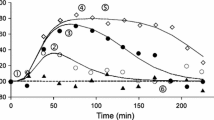Abstract
Four basic models of indirect pharmacodynamic responses were characterized in terms of changing dose, Imax or Smax, and IC50 or SC50 to examine the effects of these fundamental drug properties on response profiles. Standard pharmacokinetic parameters were used for generating plasma concentration, and response-time profiles using computer simulations. Comparisons to theoretical expectations were made. In all four models, the maximum response (Rmax) (inhibition or stimulation) and the time of its occurrence (TRmax) were dependent on the model, dose, Imax or Smax, and IC50 or SC50 values,. An increase in dose or a decrease in IC50 or SC50 by the same factor produced, as theoretically expected, identical and superimposable pharmacodynamic response patterns in each of the models. Some parameters (TRmax, ABEC) were nearly proportional to log dose, while others (Rmax, CRmax) were nonlinear. Assessment of expected response signature patterns as demonstrated in this report may be helpful in experimental designs and in assigning appropriate models to pharmacodynamic data.
Similar content being viewed by others
References
N. L. Dayneka, V. Garg, and W. J. Jusko. Comparison of four basic models of indirect pharmacodynamic responses.J. Pharmacokin. Biopharm. 21:457–478 (1993).
R. Nagashima, R. A. O'Reilly, and G. Levy. Kinetics of pharmacologic effects in man: the anticoagulant action of warfarin.Clin. Pharmacol. Ther. 10:22–35 (1969).
W. J. Jusko and H. C. Ko. Physiologic indirect response models characterize diverse types of pharmacodynamic effects.Clin. Pharmacol. Ther. 56:406–419 (1994).
K. H. Lew, E. A. Ludwig, M. A. Milad, K. Donovan, E. Middleton, Jr., J. J. Ferry, and W. J. Jusko. Gender-based effects on methylprednisolone pharmacokinetics and pharmacodynamics.Clin. Pharmacol. Ther. 54:402–414 (1993).
M. A. Milad, E. A. Ludwig, S. Ane, E. Middleton, and W. J. Jusko. Pharmacodynamic model for joint exogenous and endogenous corticosteroid suppression of lymphocyte trafficking.J. Pharmacokin. Biopharm. 22:469–480 (1995).
J. C. Dearden. Partitioning and lipophilicity in quantitative structure-activity relationships.Environ. Health Prosp. 61:203–228 (1985).
W. Krzyzanski and W. J. Jusko. Mathematical formalism for the properties of four basic models of indirect pharmacodynamic responsesJ. Pharmacokin. Biopharm. accepted (1997).
W. Krzyzanski and W. J. Jusko. Integrated functions for four basic models of indirect pharmacodynamic response. Submitted for publication (1996).
J. A. Wald, D. E. Salazar, H. Cheng, and W. J. Jusko. Two-compartment basophil cell trafficking model for methylprednisolone pharmacodynamics.J. Pharmacokin. Biopharm. 19:521–536 (1991).
H. C. Ko, and W. J. Jusko. Pharmacodynamic modeling of a 5α-reductase inhibitor: Finasteride.Pharmacother. 15:509–511 (1995).
Z-X. Xu, M. Lee, R. A. Blum, and W. J. Jusko. Pharmacodynamic modeling of prednisolone effects on natural killer cell trafficking.Pharm. Res. 12:459–463 (1995).
W. J. Jusko, H. C. Ko, and W. F. Ebling. Convergence of direct and indirect pharmacodynamic response models.J. Pharmacokin. Biopharm. 23:5–8 (1995).
A. Rescigno and G. Segre.Drug and Tracer Kinetics. Chapter 4, Blaisdell Publishing Co., New York, 1966.
L. Z. Benet. General treatment of linear mammillary models with elimination from any compartment as used in pharmacokinetics.J. Pharm. Sci. 61:536–541 (1972).
Author information
Authors and Affiliations
Additional information
Supported in part by Grant No. 24211 from the National Institute of General Medical Sciences, National Institutes of Health.
Rights and permissions
About this article
Cite this article
Sharma, A., Jusko, W.J. Characterization of four basic models of indirect pharmacodynamic responses. Journal of Pharmacokinetics and Biopharmaceutics 24, 611–635 (1996). https://doi.org/10.1007/BF02353483
Received:
Accepted:
Published:
Issue Date:
DOI: https://doi.org/10.1007/BF02353483




